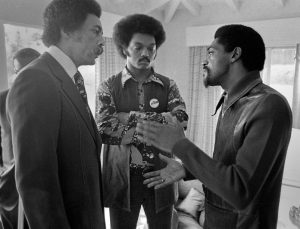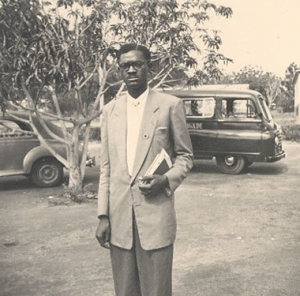With the release of Christine Blasey Ford’s lie detector test record comes the revelation that proprietary (that is, secret) software developed at the Johns Hopkins Applied Physics Laboratory, called PolyScore, was used to grade her performance as “No Deception Indicated—Probability of Deception is Less Than .02.” The gaping problem behind this sciencey statement, whether you want to believe her or not, is politely alluded to in a 2003 report from the National Research Council, which found such algorithms to be untethered from the “psychophysiological processes underlying the signals being recorded, except in a heuristic fashion.” That is, the supposed validity of the assumption that measurements made by a polygraph machine, such as skin conductance or breathing rate, can indicate when someone is lying comes from the reported experience of polygraph examiners, not from scientific research–two fundamentally different sources of information. This has always been and always will be the crucial flaw in lie detector tests. Moreover, multiple references are made throughout the NRC study to APL’s refusal to provide data about PolyScore necessary to fully critique it. APL can write complex scoring algorithms until hell freezes over, which the federal government will be happy to fund for at least that length of time, but never escape the a priori error of positing that lying makes everybody sweat, pant, and throb. The Hopkins brand name is golden window dressing for the black-box in Laurel.
Either Brett Kavanaugh or Christine Blasey Ford may be lying, but a polygraph test is tangential at best to the matter. It seems unlikely, given Ford’s scientific literacy, that she could be unaware of the polygraph’s methodological weaknesses. She testified today before the Senate Judiciary Committee that when she was interviewing attorneys, they asked her if she would be willing to take the test. She said she took it “based on the advice of counsel.” She added that she had never taken such a test before, discussed how to take one, or given other people such advice. She said that she was “scared of the test itself.” That she submitted to it on August 7 should not be held against her. Rather, here is prominent evidence of its bizarre ubiquity in Washington political and legal culture.
10/1/18: And a friend at Harvard Law. Everybody does it, so should you.
News reports that Christine Blasey Ford took a polygraph or “lie-detector” test last month in order to bolster the credibility of her accusations against Brett Kavanaugh breathe new life into one of the oldest zombies in American legal and political culture. The belief that polygraph machines can reliably sort deception from truth lives for eternity no matter how many times it is shown to be nonsense. No matter how many times the National Academies or the American Psychological Association explain why polygraphs are hokum, lawyers who ought to know better will advise their clients to get wired up to one of these pseudo-scientific thingamabobs, preferably operated by some retired FBI agent who may or may not know better. Here are a few other such immortal zombie beliefs: Harry Truman ended World War II by nuking Hiroshima, Wernher von Braun aimed at the stars, tax cuts for the rich trickle down to the poor, and Ronald Reagan won the Cold War. Evidently so many Americans need these tales so badly that historians might as well pack their shelves and retire to Tuscany. Likewise, psychologists should head permanently for Wellfleet rather than waste any more time explaining why polygraphing is junk science. The polygraph test, a sort of Grand Guignol, “works” only to the extent that it impresses foolish audiences, of which we apparently never run out. That Ford, herself a psychologist, chose to participate in this theater suggests the never-ending persuasive power of the genre in Washington. Good luck to her, in any case.

Somewhere across this mighty land, four human beings are enrolled in a secret Department of Energy experiment code-named Moose Drool. They are numbered among 331 souls in a dozen classified research projects listed by a FOIA release to the Federation of American Scientists. Now secret science is not really science, of course, removed as it is from the community of freely communicating scientists that has defined this type of endeavor since Francis Bacon’s day. So what is it? On numerous occasions since World War II, secret research sponsored by the U.S. Government has amounted to criminal abuse of unwitting subjects. (No one should be reassured by the Energy Department’s ranking of risk in the various experiments as “minimal.”) Arduous investigations by journalists and official committees long after the fact have placed some of these horrors in the public record. But there is no way to know whether the historical account is complete. There is no way to know what Moose Drool is, other than perhaps a stupid joke by some federal employee/beer-drinker who maybe thinks of himself or herself as a scientist. Bioethicists turn especially distraught about secret research, because there is no reason whatsoever to trust that the ends will justify the means.
Could it be this? This?
Vice President Pence’s speech today calling for a new military branch devoted to fighting wars in outer space helps solve at least one big problem at the Pentagon: how to spend all the money that the Trump Administration is sluicing its way. Sounding like Troy McClure, Pence might excite a few kids on summer vacation who miss the Sputnik hysteria that turbo-charged my generation’s urge to boldly go et cetera, but otherwise it was just another embarrassing hoot from the Veep. Of course the generals are lining up now to board the saucer, knowing well that there is no more powerful career booster than burning billions of dollars as fast as possible.
Update 10/23: “What price, freedom?” Pence, born in 1959, channels the Sputnik era again with Cold War magic words.

It is a long, long, long road from the Berkeley City Council to the House Armed Services Committee. That Ron Dellums started at the former in 1967 and chaired the latter in 1993 must surely rank as one of the greatest leaps in American political history. The vast majority of prominent anti-war movement voices from the 1960’s were essentially banned from national office forever, a bigoted proscription that deprived the country of many of the best of an entire generation’s natural leaders. Congress would fill to overflowing with racists and grifters, but never countenance a former “radical,” i.e. someone vehemently opposed to racists and grifters. Except for Ron Dellums (and for awhile Bella Abzug, from the West Side of Manhattan, who unfortunately never got anywhere near Armed Services). Chalk it up to the magic shield bonafides of his early stint in the Marines, perhaps, but also recognize a rare genius for bridging treacherous waters.

with Jesse Jackson and Bobby Seale, 1970
I’ve come back again to Bolinas. You might say that the highway bent its long smooth anchor about my neck and then stopped. The once famous but massively forgotten Pied Piper trout freak of the Sixties who wrote that phrase blew his brains out in the house next door and lay unmissed for more than a month. His longtime publisher, who must have been an English major, said he died of “American loneliness.” A physician might have noted alcohol dependence, severe depression, and easy access to a Smith & Wesson Model 28 revolver. By all accounts, he had devolved into a bad drunk. But that was long ago. Bolinas, the American literary scene, and every other kind of scene have moved on so far since then that the winsome writing and the horrific death might as well have never happened. The klatch of Black Mountain, San Francisco Beat, and New York School poets who gravitated here to populate a “psychedelic Peyton Place” (Ed Sanders, c. 1969) are all history, too. Frances McDormand and Joel Coen have replaced Grace Slick and Paul Kantner as the town’s celebrity couple doré–a complex differential, maybe an improvement, it’s hard to say. Yet the view from Terrace Avenue of the azure Pacific straight down the San Andreas Fault to the Golden Gate is still worth whatever it takes to get here. You would still want it to be the last thing you saw in this sad and wicked world.
Bolinas burg is much the same as in Brautigan’s time, with the giant caveat that even a 900 sq. ft. tear-down bungalow is probably worth at least a million dollars. There’s been another gold rush “over the hill” (Mt. Tamalpais, that is) in S.F., a sprawling mother lode with the highest density of billionaires in the world. So except for the alkies loitering outside Smiley’s saloon and the hard luck cases camping in junkers parked along Brighton Avenue—Bolinas traditions that go way back, like the nasturtiums—many of the resident hippie relics are worth a lot of bread. A stalwart Land Trust and a public utilility board act as politburos to preserve what is affectionately referred to as the town’s “soul,” which amounts to being a living museum of New Left ideals, a countercultural Old Sturbridge Village. The atmosphere can feel xenophobic to visitors, but it’s a rational reaction against vampire capitalists. (Marin has a deep history of property swindles. What ever happened to the Miwoks and rancheros, anyway?) Point Reyes National Seashore and decades of success at quashing local development have created the illusion of a remote village that is anything but. It will probably take an actual cataclysmic earthquake or wildfire to change the property value calculus—the mere threat, very high here, never makes much difference. Despite this real estate warp, Bolinas has fended off the kitsch despoliation that befell Key West after a similar halcyon era half a century ago. Meditate upon the difference between Gary Snyder and Jimmy Buffett. And no cruise ships. If there is another place in America with a nonprofit gas station, I would like to know where.
This morning around 5 o’clock a fire started in a storage shed next to Smiley’s, burning out the lot between the bar and a shabby house worth maybe 3 zillion. Fire engines came all the way from Nicasio, apparently without turning on their sirens, allowing me to dream serenely nearby through the commotion. An accident like this might create an opening for In-N-Out or Dogtopia in a less vigilant community. Here you can relax and go back to your manuscript. If reports are confirmed that one of Bolinas’s “below the radar,” a.k.a. homeless, people started the fire, then the compassionate tone of debate about affordable housing might stiffen slightly. But the king salmon are running offshore. Surf is up at the Patch. The President is a crook. You better find somebody to love. Plus a big wad if you want to own.
in memory of Richard Brautigan, 1935-1984, and a few fine Paradise Valley cutthroats of summer 1974

That the Department of Defense will undergo its first financial audit ever is the kind of news few people can probably relate to, like the discovery of a new terrene planet or the evacuation of a housing development built over a Hawaiian volcano. Okay, so now what? With more than $2 trillion in assets, the Pentagon has been on the Government Accountability Office’s (GAO) High-Risk list since 2015, meaning that it is “vulnerable to fraud, waste, abuse, and mismanagement.” Duh. The year 1947, when DoD was created, would be a far more historically accurate milepost than 2015, but never mind. For generations, no one has known where all the military money goes–hundreds upon untraceable hundreds of millions of dollars swirling down a bottomless drain only to be replaced by billions more every fiscal year. Vulnerable, indeed–a veritable honey pot for swindlers, many of whom have worn uniforms or at least white collars. As iconic as the fighter planes, bombers, warships and ICBMs, massive waste has been the perennial face of the Pentagon, far beyond $43 million proof-of-concept gas stations. An audit is a sick joke at this point, necessary but risible, like requiring home smoke alarms at Leilani Estates.
And the accounting standards are laughable, too.
No secret like a lucrative secret.

Around the same time that the Pentagon was learning how to control independent battlefield news reporting by “embedding,” i.e. leashing, professional correspondents in deployed units, executive editor Abe Rosenthal hired a general to cover the military for the New York Times. Bernard Trainor stepped directly from 39 years in the Marine Corps into the Times newsroom, where you can reasonably assume that Abe was as enthralled by his medals as Trump was of John Kelly’s. Apparently not content to cultivate another camp follower to replace Drew Middleton, Abe went straight for the brass. A hidebound Cold War reactionary who kept his workers under his thumb via a reign of my-way-or-the-highway terror, Rosenthal built the foundation for an interventionist cadre of Times reporters that continues to this day. On the run-up to war and for as long as possible until everything goes terribly wrong, which has been the rule since 1945, readers can expect lots of positivity, not skepticism, from the Gray Lady. (Those old enough to remember the paper’s Vietnam coverage know that it was one of the primary forces fueling the growth of an “underground” or alternative press, no matter how much self-aggrandizing retrospection appears nowadays about Halberstam, Sheehan, and the Pentagon Papers. The New York Times was a deeply pro-war news company.) Could a Trainor type find a comfortable desk there again? It’s not hard to imagine Abe becoming enamored of H.R. McMaster, say. But Abe is long gone and represented a mix of bigotries unlikely to be tolerated today at the top of the masthead. Besides, you don’t have to hire generals to write the news anymore–not with all those football-field sized American flags being constantly unrolled across the land.
When the son of a hardscrabble Wyoming Valley, Pennsylvania, insurance agent found himself one September morn in the same Princeton dorm room as Donald Rumsfeld, part of a freshman class of ’52 that included James Baker, you might say that stars were ominously aligned. This side of paradise was about to get nastier. None of these young go-getters would ever deviate from career paths lubricated by the easiest grease America had to offer its ambitious best-and-brightest: hardline anti-communism mixed with military-industrial fortune. If rising to the top is what you crave, that slickum is guaranteed to work like a charm. Your soul might get a little singed along the way (“Ou est Carlucci?”–where’s Carlucci?–the grateful new Congolese prime minister famously asked upon meeting a clueless JFK after the murder of Patrice Lumumba), but what the heck. So let us raise a glass of the devil’s brew to this scion of Scranton, Old Nassau, the CIA, the Pentagon, and the Carlyle Group. You did them proud, Frank, and left the world a . . . well, a viler damned place, it’s fair to say.

Patrice Lumumba, c. 1952
“If activists want to make headway on reining in gun violence, they need to understand gun culture.” So opines the subtitle of a recent article in Texas Monthly about why there will be no grassroots movement coming out of the Lone Star State after the Santa Fe school massacre. It’s a mistake, we learn from a Houstonian who wrote the piece, “to harbor the liberal East Coast condescension” that Texans who carry firearms are crazy. No one is quoted with those words about Yankee snobs, so it must be taken for granted by the reader that they exist as a widespread phenomenon. One particular paragraph should be repeated in full here, because otherwise you might think I’m making it up:
“Hunting and plinking at cans are recalled fondly by many in Texas as bonding activities with their parents. Guns are heirlooms passed down through generations and are used to hunt the Thanksgiving turkey and Christmas goose. Moreover, millions nationwide participate in tactical or sharpshooting competitions and belong to gun clubs that are the focal points of their social lives. Those enmeshed in gun culture take pride in their safety-mindedness and technical skills as well as their ability to protect themselves and their families if necessary.”
Exactly, yes. Searching American history for an analogous cultural identity marker that was as divisive as gun ownership, let us consider slavery, which was also a deeply embedded feature of selfhood embraced by countless Texans on all rungs of the social ladder–rednecks, politicians, attorneys, grandmothers, professors, clergy, journalists, etc, etc, etc. The shelves of a good university library today, even in the South, groan under the weight of scholarship devoted to portraying the antebellum normalcy of human beings as livestock, whether you owned some or not. Telling abolitionists in those days that they needed to accept the validity of the pro-slavery point of view led straight to Gettysburg.
So we can only pray–they do this everywhere in Texas, too, I hear from my book-lined study on the East Coast–that the editors and writers at Texas Monthly may come miraculously to see gun control or, dare we say, gun abolition (take that concealed handgun from granny right now!) as a moral and sociopolitical imperative, thereby joining not only the haughty East Coast, but every advanced nation in the world.

|






